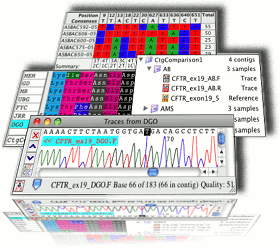

#Codoncode aligner ver. 2 full version#
The first beta version of CodonCode Aligner was released in April 2003, followed by the first full version in June 2003. Proprietary, without charge for educational, research and non profit.Features include chromatogram editing, end clipping, and vector trimming, sequence assembly and contig editing, aligning cDNA against genomic templates, sequence alignment and editing, alignment of contigs to each other with ClustalW, MUSCLE, or built-in algorithms, mutation detection, including detection of heterozygous single-nucleotide polymorphism, analysis of heterozygous insertions and deletions, start online BLAST searches, restriction analysis (find and view restriction cut sites), trace sharpening, and support for Phred, Phrap, ClustalW, and MUSCLE. Standard Needleman-Wunsch dynamic programming algorithm Opensource Smith-Waterman for SSE/CUDA, Suffix array based repeats finder & dotplot Miller)Īligns nucleic acid sequences given a protein alignment Memory-optimized Needleman-Wunsch dynamic programming Java applet demonstrating various algorithms from Local ( Smith-Waterman) alignment with statistics Local similarity with varying gap treatments "align" command aligns sequence & applies it to structureĪlignment using predicted Connectivity Profilesį. Stochastic partition function sampling via dynamic programming Smith-Waterman on protein back- translation graph (detects frameshifts at protein level) Logarithmic and affine gap costs and explicit models of indel evolution

Waterman-Eggert local alignment (based on LALIGN) Modelling alignment models the information content of the sequences Multiple, non-overlapping, local similarity (same algorithm as SIM) Protein sequence to structure alignment that includes secondary structure, structural conservation, structure-derived sequence profiles, and consensus alignment scores Open source Java implementation of Smith-Waterman GapMis is a tool for pairwise sequence alignment with a single gap GPU-based dynamic programming with backtracking Posterior based local extension with descriptive evolution model Forrestīioconductor Biostrings::pairwiseAlignment Smith-Waterman search, slower but more sensitive than FASTAįast heuristic anchor based pairwise alignmentĪlignments for membrane protein sequences

Linking and profiling sequence alignment data from NCBI-BLAST results with major sequence analysis servers/services Li W, McWilliam H, Goujon M, Cowley A, Lopez R, Pearson WR Position-specific iterative BLAST, local search with position-specific scoring matrices, much more sensitive than BLASTĪltschul SF, Madden TL, Schäffer AA, Zhang J, Zhang Z, Miller W, Lipman DJ Ĭombining the Smith-Waterman search algorithm with the PSI-BLAST profile construction strategy to find distantly related protein sequences, and preventing homologous over-extension errors. Pairwise comparison of profile Hidden Markov models very sensitive, but can only search alignment databases (Pfam, PDB, InterPro.) Local and global search with profile Hidden Markov models, more sensitive than PSI-BLASTĭurbin R, Eddy SR, Krogh A, Mitchison G Global:Global (GG), Global:Local (GL) alignment with statistics Local search with fast k-tuple heuristic, slower but more sensitive than BLAST GPU accelerated Smith Waterman algorithm for multiple shared-host GPUs Position-specific iterative version CSI-BLAST more sensitive than PSI-BLASTĪngermueller C, Biegert A, Soeding J Sequence-context specific BLAST, more sensitive than BLAST, FASTA, and SSEARCH. NCBI EBI DDBJ DDBJ (psi-blast) GenomeNet PIR (protein only)Īltschul SF, Gish W, Miller W, Myers EW, Lipman DJ Local search with fast k-tuple heuristic (Basic Local Alignment Search Tool)


 0 kommentar(er)
0 kommentar(er)
